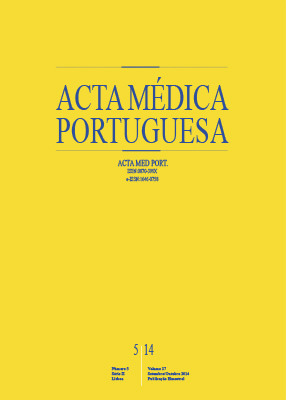Treatment of Inflammatory Bowel Disease: Is your Patient at Risk of Non-Adherence?
DOI:
https://doi.org/10.20344/amp.5090Abstract
Introduction: Adherence to therapy is a key factor when analyzing the efficacy of a treatment in clinical practice. The aim of our study was to assess the frequency of non-adherence to treatment among patients with inflammatory bowel disease and evaluate which factors could be related.
Material and Methods: One hundred thirty eight consecutive inflammatory bowel disease outpatients (55.8% with Crohn’s disease and 44.2% with Ulcerative Colitis) filled in an anonymous questionnaire, which included information about demography, duration of the disease, specific therapy for inflammatory bowel disease, and data possibly related to extent of non-adherence to treatment. Statistics were performed with SPSS v.18.0. Categorical variables were compared with Fisher’s exact test. A p value < 0.05 was considered statistically significant. Significant variables in univariate analysis were included in the logistic regression analysis.
Results: Overall non-adherence was reported by 29.7% of patients. 70.7% of them reported unintentional non-adherence and 51.2% forgot at least one dose per week. Non-adherence was statistically associated with: short disease duration (p < 0.001); young age (p = 0.001); topical aminosalicylates (p = 0.005); the perception that medical therapy isn’t effective enough (p = 0.007) and high educational level (p = 0.011). In a logistic regression analysis, topical aminosalicylates use (p = 0.004), short disease duration (p = 0.006) and young age (p = 0.027) were identified as significant predictors of non-adherence.
Discussion: Young patients, patients with short disease duration and under topical aminosalicyates presented a higher risk for nonadherence to treatment.
Conclusions: Gastroenterologist’s attention should be focused on the identification of risk factors potentially involved in non-adherence to therapy and in the promotion of measures to improve it.
Keywords: Inflammatory Bowel Disease; Crohn Disease; Colitis, Ulcerative; Patient Compliance; Risk Factors; Treatment Refusal.
Downloads
Downloads
Published
How to Cite
Issue
Section
License
All the articles published in the AMP are open access and comply with the requirements of funding agencies or academic institutions. The AMP is governed by the terms of the Creative Commons ‘Attribution – Non-Commercial Use - (CC-BY-NC)’ license, regarding the use by third parties.
It is the author’s responsibility to obtain approval for the reproduction of figures, tables, etc. from other publications.
Upon acceptance of an article for publication, the authors will be asked to complete the ICMJE “Copyright Liability and Copyright Sharing Statement “(http://www.actamedicaportuguesa.com/info/AMP-NormasPublicacao.pdf) and the “Declaration of Potential Conflicts of Interest” (http:// www.icmje.org/conflicts-of-interest). An e-mail will be sent to the corresponding author to acknowledge receipt of the manuscript.
After publication, the authors are authorised to make their articles available in repositories of their institutions of origin, as long as they always mention where they were published and according to the Creative Commons license.









